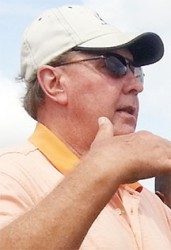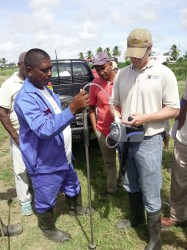NABI Oil and Gas Inc. a new entrant to the petroleum exploration industry, has commenced onshore activities in Mahaica/ Mahaicony and is hopeful that given the evidence unearthed so far that it will be able to find commercial quantities of hydrocarbons.
This was disclosed during a media tour of the site for the ongoing exploration along the De Hoop Branch Road, one of three such onshore petroleum exploration campaigns. So far, NABI Oil and Gas Inc., a subsidiary of the NABI Construction company, has spent some $70 million in the current efforts.
Speaking to members of the media, President of Hydrocarbon Imaging Services Inc. Bob Clark said, “Basically we are very encouraged by the trends that we see. Now the work is afoot where we find the boundaries and see the commercial viability.”

“We have been active in Peru, in South America… we have been active over the last five years. Also in Trinidad. And we have worked coast to coast, north to south and east to west in the United States,” he said. “So we have a good idea of comparisons,” he said.
He noted that while there is a lot of anecdotal information, there is very sketchy information on historical wells. But even with that, he said his company would still have an idea of the boundaries and the identifying signatures for oil and gas. “With Suriname to the east and Venezuela [to the west] there should be hydrocarbon here. It all comes down to commercial quantities,” he added.
The survey method being used is what is known in the industry as surface or fluid logging.
“In our science we look at two things. We look at the natural gamma rays signatures. The earth is inherently radioactive and that gives us a clue going into some of the identifying factors,” he explained.

Clark noted that the company will also be searching for soil gases by bringing the laboratory to the field and using sophisticated instruments to identify methane gas signatures, carbon dioxide. “More clues, more DNA, if you will, and then we do our grids,” he said. “If we think there is a trend, if it is consistent with the cretaceous (period) which we think it is here… a shallow, heavier oil similar to Venezuela, then we can start seeing boundaries. What we are trying to do is find the sweet spots and then we bring in other sciences, whether it is seismic or another, to see structure,” he added, while noting the importance of integrate historical geology with historical well control.
“We have a science that is mathematically-based, that is nuclear based, that is predictable and repeatable,” Clark said.
According to Clark, using Suriname as a thumbprint, the drill sites may have to be drilled to a depth of between 1,500 feet and 1,800 feet. “This is very cost effective and should be very attractive to the drilling people,” he pointed out .
Asked how soon the company would know what amounts are there, Clark said that his company could have an answer within weeks. He said that at this point when the answer is given, further analyses would be needed to determine cost effectiveness before the next steps could be determined. He said too that since the occurrence of oil and gas would not likely stop at the shoreline, the company will also be conducting surveys offshore in due course.
Anthony Syms is the Managing Director of NABI Oil and Gas Inc. He said that the company started in the last part of 2010 and it acquired a lease for land at Mahaica/Mahaicony in 2012. “We got into an arrangement with hydrocarbon imaging in mid-2013 and they started their homework and now we are out here picking as much data as is humanly possible,” he said.
“The decision where to drill is important because it also has to be cost efficient and cost effective,” Syms said. “Commercial quantities are what we are looking for,” he said. “To make it into a viable business proposition the cost of production must be less than the actual selling price, or else we don’t have a business… and we are in business,” he said.
Syms said that guiding the decision to drill onshore is that while the wells may not be as prolific as offshore, cost of production can be controlled.
Minister of Natural Resources and the Environment Robert Persaud said that while the emphasis has been on deep offshore, based on earlier exploration activities there has been some indication that there is some form of hydrocarbon potential onshore.
“These are very early days and it is always good that we temper expectations. There are many more stages that this company or any exploration company would have to undertake to get to that point,” he said.
Canadian explorer CGX, Takutu Oil and Gas Inc and Hunt Oil are some of the companies that have attempted onshore wells in recent years without detecting oil in commercial quantities.





